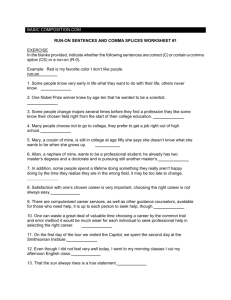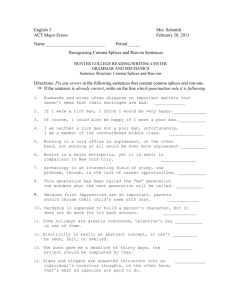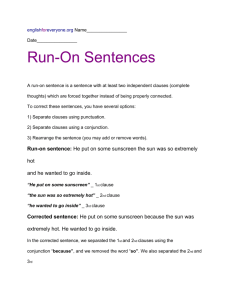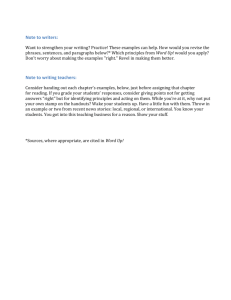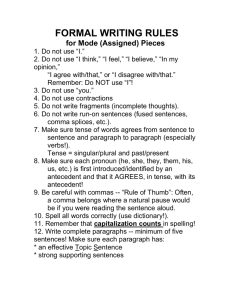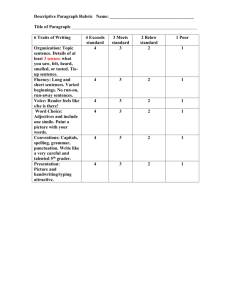Word-Up-exercises
advertisement
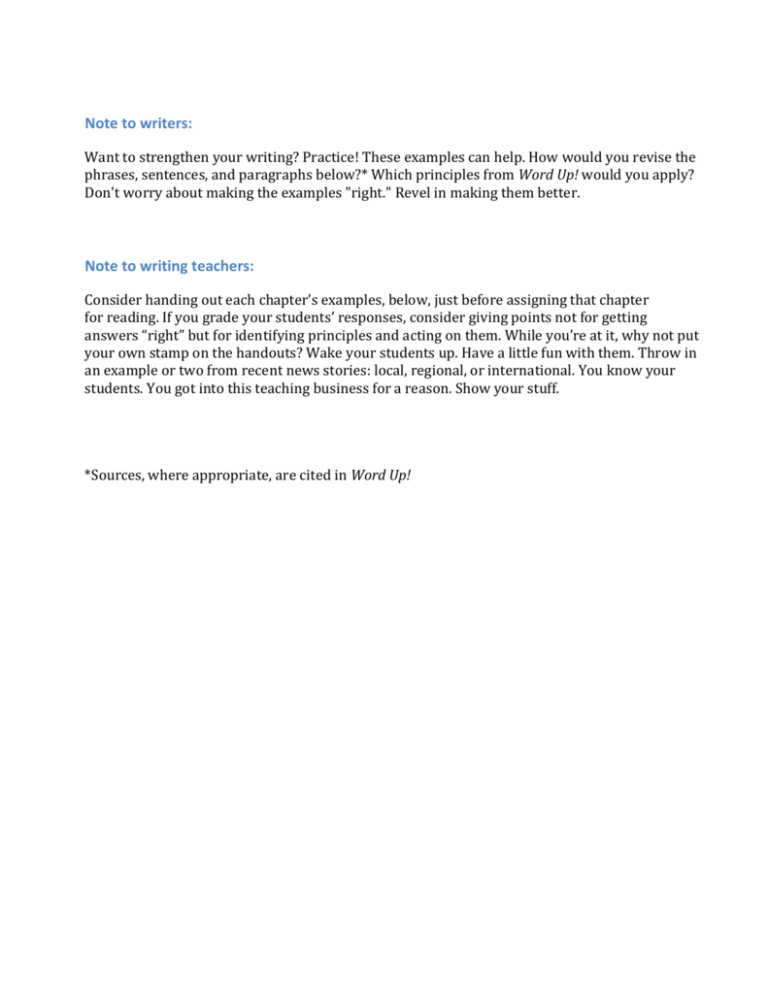
Note to writers: Want to strengthen your writing? Practice! These examples can help. How would you revise the phrases, sentences, and paragraphs below?* Which principles from Word Up! would you apply? Don't worry about making the examples "right." Revel in making them better. Note to writing teachers: Consider handing out each chapter’s examples, below, just before assigning that chapter for reading. If you grade your students’ responses, consider giving points not for getting answers “right” but for identifying principles and acting on them. While you’re at it, why not put your own stamp on the handouts? Wake your students up. Have a little fun with them. Throw in an example or two from recent news stories: local, regional, or international. You know your students. You got into this teaching business for a reason. Show your stuff. *Sources, where appropriate, are cited in Word Up! Chapter: “To Be or Not To Be” Examples from the Chapter 1. Education’s purpose is to replace an empty mind with an open one. 2. Nothing is more revealing than movement. 3. A scheme of which every part promises delight can never be successful. 4. In all pointed sentences, some degree of accuracy must be sacrificed to conciseness. 5. Our product is better than your product. Bonus 1. Aspirin is something that is good for relieving pain. 2. Does the content that’s on your web page meet the reader’s needs? 3. Thanks for celebrating with me. It was a milestone day. 4. A mind-boggling amount of data is now able to be pushed to us on mobile devices. 5. Bias tape, a tailor’s dream, has the advantage of being able to be applied smoothly around curves as well as straight. 6. Another common request is being able to integrate search functionality. 7. It’s worth noting that most readers do not want to wade through huge volumes of information to find what they need. Principles I Applied from this Chapter Describe in your own words. Chapters: “Talk—I Mean Obfuscate—Your Way to the Top” or “Metaphors Are Jewels” Bonus (If you’ve never heard these phrases, consider yourself lucky. You can skip ahead.) 1. Go after the low-hanging fruit that we can pull onto the new platform. 2. You don’t need to boil the ocean right out of the gate. Principles I Applied from this Chapter Describe in your own words. Chapter: ”The Only Thing That These Signs Have in Common” Examples from the Chapter 1. I only drink to make you more interesting. 2. Quality only happens when you care to do your best! 3. I only have a kitchen because it came with the house. 4. I can only please one person a day. 5. Change only available with postal transaction. 6. Casket for sale—only used once. Bonus I’m only going to say this once: put only where it goes. Principles I Applied from this Chapter Describe in your own words. Chapter: ”Her and I: How to Banish Painful Personal-Pronoun Pairings” Examples from the Chapter 1. My father is living with my wife and I. 2. Him and I went fishing this morning. 3. Him and me went to the store to get ice cream. 4. The armchair was big enough for her and I. 5. Are you coming to the game with she and I? 6. Her and I will drive you home. 7. That hybrid truck is perfect for her and I. 8. Throw the football to me and her. 9. Build he and I a house. 10. Want to hear about he and I’s plan? 11. The bleachers have plenty of empty spots for we and them to sit. 12. With practice, me and him learned new grammar habits. Bonus 1. Last night, me and my friend went to the new Thai restaurant. 2. Let’s keep this a secret between you and I. 3. Let’s keep this a secret between me and you. Principles I Applied from this Chapter Describe in your own words. Chapter: “To Each Their Own” Examples from the Chapter 1. To each their own. 2. Open the profile of a friend, and add their phone number so it’s easy to call them. 3. Health management allows one to take care of themselves. 4. As the lover seeks their beloved, so must you focus on what you want. 5. Jane wants to add you to their network. 6. Jim has updated their profile. Bonus 1. Encourage your client to clarify their communication goals. 2. You don’t want to be that guy rushing around at the last minute searching for a tie to match the dress their date is wearing to the big dance. 3. We need a designer who is eager to get their hands dirty tackling complex problems. Principles I Applied from this Chapter Describe in your own words. Chapter: “Whom Ya Gonna Call?” Examples from the Chapter 1. Who’s she calling offended? 2. Who did you walk with? 3. Who should we follow? Bonus 1. Why argue as to whom should be blamed? 2. In the man’s place was a boy who looked like him and whom I assumed was his son. 3. There’s the girl whom we believed was lost. 4. George wondered whom he might be for the rest of this life. Principles I Applied from this Chapter Describe in your own words. Chapter: “Hyphens Unite!” Examples from the Chapter 1. (sign) Fear free dentistry 2. (headline) A father son bond so close, they’re joined at the liver 3. Marie’s dad swears that next December he will avoid the last minute shopping frenzy. Principles I Applied from this Chapter Describe in your own words. Chapter: “To Hyphenate or Not To Hyphenate After a Noun: That Is the Wrong Question” Examples from the Chapter 1. This job is long term. 2. That child is razor-sharp. 3. The suit is blue-green. Principles I Applied from this Chapter Describe in your own words. Chapter: “Let Me Count the— Different?—Ways” Examples from the Chapter 1. A dozen different bridges 2. Two different sheep 3. A lot of different charities Bonus 1. You can get downtown a few different ways. 2. At the Mexican restaurant, my friend and I shared three different entrees. 3. Check out the twenty different shirt styles. 4. Costs vary between different laptop models. Principles I Applied from this Chapter Describe in your own words. Chapter: “The Pen Is Mightier Than the Shovel” Examples from the Chapter (You can just mark these up.) 1. Many adverbs, especially the ones that end with -ly, actually, truly, frankly, extremely, definitely, totally, really, simply, literally, basically have less substance than the weightless, drifting snow that Eskimos call weightless, drifting snow. Relentlessly chip away adverbs that redundantly repeat the meaning of the verb. 2. Despite their reputation as intensifiers, very, such, and so fail to intensify. When you come across one of these wimpy so-called intensifiers, hurl it into the bushes, and put a brawny verb to the heavy lifting. I have a very strong desire to clear … I have such a strong desire to clear … I soooooo want to clear … I long to clear this walkway. 3. Negative words often do not have muscle. 4. Does the fact that you’re sitting comfortably have you feeling guilty about others doing all the shoveling? 5. Just say no to just. Just just gets in the way. Sometimes it just slips out, especially right before a verb where it just adds no value. It just happens. Just forgive yourself, just delete it, and just move on. 6. Don’t begin to describe the beginning of an action. Cut to the action itself. Start to get to work! 7. Tend to avoid tend to. 8. Put on a wool hat in order to keep your ears warm. 9. If you say you don’t want to shovel at this point in time, you sound like you’re running for office. Admit that you don’t feel like doing it now. Remember, though, that the snow will only get heavier and crustier if you go after it at some future point in time. 10. You have too much to accomplish to waste even the brief period of time it takes to say period of. 11. In spite of its innocent looks, the innocent-looking little word of (“in anything other than small doses”) has been called “among the surest indications of flabby writing.” In terms of tight writing, strong writers use few ofs. Stay strong! Avoid the preposition of, in spite of its siren song! Did you ever consider of that big of a deal? 12. You may or may not finish the job today. 13. Let’s dump the proverbially annoying word proverbial. 14. Are you of two different minds about whether to use the term different after a number? 15. Be smart; take a break. 16. People could slip on that sidewalk, but I don’t feel like clearing it. 17. The particular word particular only gets in your way. 18. Eliminate all manner of overabundant, superfluous, or worn-out words, aka verbiage. Bonus 1. All stakeholders must understand the project scope, at least at a pretty high level. 2. Set your camera lens to the smallest f-stop number to let in the maximum amount of light possible. 3. It’s very easy even for highly skilled professionals to underestimate the value of tight writing. Principles I Applied from this Chapter Describe in your own words. Chapter: “The Last Word” Examples from the Chapter 1. The principle that the proper place for what is to be made most prominent is the end applies equally to the words of a sentence, to the sentences of a paragraph, and to the paragraphs of a composition. 2. But what product should the reporter focus on? He considered several and finally landed on a doozy. It was the McDonald’s frozen french fry—if anything linked the Pacific Northwest to the Asian economic crisis, that was it. It flowed to the Pacific Rim in vast quantities, where sales depended on the growing middle class, the group most threatened by the economic crash. Our region dominated its production. It was familiar, low-tech, nonthreatening, and easy to understand. Bonus Put the most important word at the end of a sentence so that your point doesn’t get weakened by other words trailing along afterward. Principles I Applied from this Chapter Describe in your own words. Chapter: “A Definition Is Where You Don’t Say Is Where“ Examples from the Chapter 1. A gravy train is where someone makes lots of money without doing much for it. 2. A retweet is where you forward a tweet. 3. Horticulture is where people grow plants. Principles I Applied from this Chapter Describe in your own words. Chapter: “Lend Your Commas a Hand—or Two” Examples from the Chapter (You can just mark these up.) 1. Fruit flies, for example can breed up to ten times an hour. 2. The TV however, sat idle. 3. My pal Gerry, a baker learned to love the sunrise. 4. The house that Sandee likes, the one with the striped curtains and the funny gargoyle on the second story went up for sale last week. 5. The plane will land in Portland, Maine right on time. 6. The letter dated January 2, 1987 changed George’s life. 7. Macy’s, Inc. made headlines today. 8. Rodney, Jr. has a birthday coming up. Principles I Applied from this Chapter Describe in your own words. Chapter: “Running On about Run-Ons” Examples from the Chapter (You can just mark these up.) 1. I didn’t plan to write about run-on sentences, a much-hyped book by a respected author shocked me into it, run-on sentences, the kind formed by comma splices, litter the pages, it ain’t pretty. 2. Think punctuation doesn’t affect your bottom line? Ask Amazon, Leo Frishberg, a userexperience pro says that Amazon tests its web pages to compare the effects of sentencelevel differences a semicolon vs. a period for example on usability Amazon not only cares about getting the punctuation correct but also measures (read invests money to determine) which of various correct possibilities elicits a better response, powerful testimony! 3. A comma splice is a comma between independent clauses, the comma joins (splices) the clauses together into a run-on sentence, comma splices work well for connecting short independent clauses, as in I came, I saw, I hopped the bus home, otherwise, comma splices make reading a chore. 4. Some run-on perpetrators dispense with the comma splice altogether they fuse independent clauses together without a wisp of punctuation to give readers a clue one clause merges into the next buffered by nothing but a space some writers use this kind of run-on sentence (a fused sentence) to advantage if you know what you’re doing you can too but unless you’re after a breathless quality or a stream-of-consciousness effect don’t fuse your sentences punctuate them. 5. Avoid joining independent clauses with either commas or spaces, this is an independent clause this is too each independent clause has a subject and a verb and forms a complete thought. 6. You can fix a run-on sentence, whether it’s spliced or fused, in lots of ways. You can always insert a Superman of a separator (a period, a semicolon, a colon, or a dash depending on the relationship between the two independent clauses) you don’t have to limit yourself to punctuation marks alone. Get a little wild! Slip in an occasional coordinating conjunction (like but or and) coupled with a comma you’ll win readers’ hearts every time. 7. You can also fix run-on sentences by subordinating one of the clauses. In other words, use a subordinating conjunction (like because) to turn one of the independent clauses into a dependent clause, exposing a logical relationship. Of course, you can’t use this technique to fix every run-on sentence that kind of logical relationship doesn’t always exist. 8. You may wonder how to determine the best fix for a run-on sentence consider two things the way the parts of the sentence relate to each other and the “tone and rhythm” that fit your context you may want to rewrite the whole thing. Bonus Creating e-books reminds me of the early days of desktop publishing, only we are working in code now, we don’t have an easy method for layout. Principles I Applied from this Chapter Describe in your own words. Chapter: “Touching Words” Examples from the Chapter 1. As an expectant mother of five, my ironing board is always up. 2. As a nature lover, I’m sure you would agree that this land is worth preserving. 3. One morning I shot an elephant wearing my pajamas. 4. Demolition crews have finally removed an old house near the Capitol Building, whose owners had previously refused to leave. 5. Sal skimmed these bestsellers while at the library: Unbroken, Freedom, and Words Fail Me. 6. There are three choices in this life: be good, get good, or give up. 7. These are the four most beautiful words in our common language: I told you so. 8. I like to knit with yarns that feel soft: mohair, silk, and— softest of all—bamboo. 9. Frank picked up a discarded pizza box. The party had gone on for hours, and he was tired. He wanted to hit the sack. But it had made the apartment look messy. 10. The plan for doing the marketing via the website is coming together. 11. The foundation of the old house cracked. Bonus 1. As an adult with a paycheck, my knickknack collection expanded. 2. The plan announced Monday for a bridge to be built across Seneca Lake has been protested by residents. 3. These are the top two qualities the company wants to include in its brand: innovation and excellence. 4. The jurors' request to hear the testimony again just minutes before they reached their verdict puzzled the experts. 5. Employees must wash all their hands. Principles I Applied from this Chapter Describe in your own words. Chapter: “Your Words Come Alive with a Hint of Music” Examples from the Chapter Jotting down a list of things Or series of like phrases? Keep the structure parallel: All nouns, all verbs, all whatever as long as no clunkers break the pattern. Okay, that's a trick example. You can't exactly fix it. Get extra credit by explaining why. Principles I Applied from this Chapter Describe in your own words. Chapter: "Coming Soon to the Small Screen" Examples from the Chapter Build a paragraph by arranging these sentences in logical order. You might find it helpful to snip these out and move them around. They’re not chasing after copy that’s skimpy. Don’t stop there. Let’s say that you now regularly cut every bit of text you can. As author William Zinsser advised back when typewriters ruled, “strip your writing down” and then “build it back up.” Remember the complementary necessity: adding. Go after thin copy. Ask yourself, What else would readers appreciate? Small screen, schmall screen. They want copy that answers their questions, copy that’s coherent, logical, useful, convincing, relevant, inspiring, edifying, amusing, fresh, clarifying, and sufficiently detailed. Your readers’ fingers are flicking for a reason.
